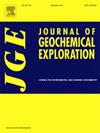源富集和晚期热液活动对东北782号REE-Nb-Zr矿床形成的贡献
IF 3.3
2区 地球科学
Q1 GEOCHEMISTRY & GEOPHYSICS
引用次数: 0
摘要
花岗岩型稀有金属和稀土元素矿床因其在提供关键金属资源方面的战略意义而受到学术界和工业界的广泛关注。然而,控制grmed形成的关键因素在经验上仍然不明确。在中国东北782号REE-Nb-Zr矿床中,可识别出3个不同时期的花岗岩:成矿前二长花岗岩、同成矿花岗岩杂岩(由黑云母花岗岩-白云母花岗岩-钠长花岗岩组成)和成矿后同长花岗岩。对这些侵入相的系统成岩研究为研究grmed系统固有的元素超富集机制提供了重要的见解。锆石UPb年代学约束显示,二长花岗岩的连续侵位年龄为488±4 Ma,矿化杂岩为458±4 Ma,正长花岗岩为451±4 Ma。Zr + Ce + Nb + Y浓度升高(330 ~ 544 ppm), 1万× Ga/Al比值升高(2.93 ~ 3.40),Eu负异常(Eu/Eu* = 0.15 ~ 0.29),与伸展构造下形成的岩浆岩特征一致。二长花岗岩、黑云母花岗岩和正长花岗岩的锆石εHf(t)值分别为4.2±0.93‰(1σ, n = 19)、3.6±0.63‰(1σ, n = 10)和5.4±0.82‰(1σ, n = 10), δ18O值分别升高7.72±0.80‰(1σ, n = 15)、7.45±1.23‰(1σ, n = 10)和7.06±0.74‰(1σ, n = 20),表明锆石来源于下地壳幼年源。我们的地球化学数据揭示了成矿元素的明显变化:二长花岗岩显着衰竭,与黑云母花岗岩和正长花岗岩显着富集形成对比。这一结果表明,二长花岗岩可能来自于成矿元素枯竭的地壳源,而花岗岩杂岩和正长花岗岩中成矿元素的富集可能归因于地幔源中富氟挥发性组分的掺入。花岗岩杂岩呈现出明显的HREE和HFSE分布模式,其中黑云母花岗岩表现为中度的HREE- nb富集,钠长岩花岗岩表现为显著富集(∑REE可达2850 ppm),白长岩花岗岩表现为相对富集。这种分布差异表明,白长石化过程中的元素再活化和随后的钠长石化沉淀是稀土超富集的主要机制。因此,我们认为GRMEDs的形成需要两个基本且相互依存的条件:(1)幔源挥发物通过下地壳交代作用产生肥沃岩浆;(2)岩浆演化后期通过热液活动提取和再富集金属。本文章由计算机程序翻译,如有差异,请以英文原文为准。
Contributions from source enrichment and late hydrothermal activity to the formation of the No. 782 REE-Nb-Zr deposit, NE China
Granite-type rare metal and rare earth element deposits (GRMEDs) have garnered significant attention from both academia and industry owing to their strategic importance in supplying critical metal resources. Nevertheless, the critical factors controlling the formation of GRMEDs remain empirically ambiguous. In the No. 782 REE-Nb-Zr deposit, NE China, three distinct periods of granites have been recognized: pre-mineralization monzogranite, syn-mineralization granitic complex comprising biotite granite-muscovitized granite-albitized granite, and post-mineralization syenogranite. Systematic petro-genetic investigations of these intrusive phases provide crucial insights into element super-enrichment mechanisms inherent to GRMEDs systems. Zircon U![]() Pb geochronological constraints reveal successive emplacement ages of 488 ± 4 Ma for monzogranite, 458 ± 4 Ma for the mineralized complex, and 451 ± 4 Ma for syenogranite. These granites exhibit diagnostic A-type affinities manifested by elevated Zr + Ce + Nb + Y concentrations (330–544 ppm), enhanced 10,000 × Ga/Al ratios (2.93–3.40), and pronounced negative Eu anomalies (Eu/Eu* = 0.15–0.29), consistent with magmatic rocks formed under extensional tectonics. Zircon grains from the monzogranite, biotite granite and syenogranite show positive εHf(t) values of 4.2 ± 0.93 ‰ (1σ, n = 19), 3.6 ± 0.63 ‰ (1σ, n = 10) and 5.4 ± 0.82 ‰ (1σ, n = 10), respectively, coupled with elevated δ18O values of 7.72 ± 0.80 ‰ (1σ, n = 15), 7.45 ± 1.23 ‰ (1σ, n = 10) and 7.06 ± 0.74 ‰ (1σ, n = 20), respectively, indicative of derivation from juvenile lower crustal sources. Our geochemical data reveal distinct variations in ore-forming elements: the monzogranite shows significant depletion, contrasting with pronounced enrichment in the biotite granite and syenogranite. This result suggests that the monzogranite was likely derived from a crustal source depleted in ore-forming elements, while the enrichment of ore-forming elements in the granitic complex and syenogranite may be attributed to the incorporation of fluorine-rich volatile components from mantle sources. Furthermore, the granitic complex displays distinct HREE and HFSE distribution patterns, where biotite granite shows moderate HREE-Nb enrichment, albitized granite demonstrates significant enrichment (∑REE up to 2850 ppm), while muscovitized granite exhibits relative depletion. This differential distribution implies that element remobilization during muscovitization and subsequent precipitation through albitization constituted the dominant mechanism for rare earth super-enrichment. We therefore propose that the formation of GRMEDs requires two essential and interdependent conditions: (1) the generation of fertile magma through lower crustal metasomatism by mantle-derived volatiles, and (2) subsequent metal extraction and reconcentration via hydrothermal activity during the late magmatic evolutionary stages.
Pb geochronological constraints reveal successive emplacement ages of 488 ± 4 Ma for monzogranite, 458 ± 4 Ma for the mineralized complex, and 451 ± 4 Ma for syenogranite. These granites exhibit diagnostic A-type affinities manifested by elevated Zr + Ce + Nb + Y concentrations (330–544 ppm), enhanced 10,000 × Ga/Al ratios (2.93–3.40), and pronounced negative Eu anomalies (Eu/Eu* = 0.15–0.29), consistent with magmatic rocks formed under extensional tectonics. Zircon grains from the monzogranite, biotite granite and syenogranite show positive εHf(t) values of 4.2 ± 0.93 ‰ (1σ, n = 19), 3.6 ± 0.63 ‰ (1σ, n = 10) and 5.4 ± 0.82 ‰ (1σ, n = 10), respectively, coupled with elevated δ18O values of 7.72 ± 0.80 ‰ (1σ, n = 15), 7.45 ± 1.23 ‰ (1σ, n = 10) and 7.06 ± 0.74 ‰ (1σ, n = 20), respectively, indicative of derivation from juvenile lower crustal sources. Our geochemical data reveal distinct variations in ore-forming elements: the monzogranite shows significant depletion, contrasting with pronounced enrichment in the biotite granite and syenogranite. This result suggests that the monzogranite was likely derived from a crustal source depleted in ore-forming elements, while the enrichment of ore-forming elements in the granitic complex and syenogranite may be attributed to the incorporation of fluorine-rich volatile components from mantle sources. Furthermore, the granitic complex displays distinct HREE and HFSE distribution patterns, where biotite granite shows moderate HREE-Nb enrichment, albitized granite demonstrates significant enrichment (∑REE up to 2850 ppm), while muscovitized granite exhibits relative depletion. This differential distribution implies that element remobilization during muscovitization and subsequent precipitation through albitization constituted the dominant mechanism for rare earth super-enrichment. We therefore propose that the formation of GRMEDs requires two essential and interdependent conditions: (1) the generation of fertile magma through lower crustal metasomatism by mantle-derived volatiles, and (2) subsequent metal extraction and reconcentration via hydrothermal activity during the late magmatic evolutionary stages.
求助全文
通过发布文献求助,成功后即可免费获取论文全文。
去求助
来源期刊

Journal of Geochemical Exploration
地学-地球化学与地球物理
CiteScore
7.40
自引率
7.70%
发文量
148
审稿时长
8.1 months
期刊介绍:
Journal of Geochemical Exploration is mostly dedicated to publication of original studies in exploration and environmental geochemistry and related topics.
Contributions considered of prevalent interest for the journal include researches based on the application of innovative methods to:
define the genesis and the evolution of mineral deposits including transfer of elements in large-scale mineralized areas.
analyze complex systems at the boundaries between bio-geochemistry, metal transport and mineral accumulation.
evaluate effects of historical mining activities on the surface environment.
trace pollutant sources and define their fate and transport models in the near-surface and surface environments involving solid, fluid and aerial matrices.
assess and quantify natural and technogenic radioactivity in the environment.
determine geochemical anomalies and set baseline reference values using compositional data analysis, multivariate statistics and geo-spatial analysis.
assess the impacts of anthropogenic contamination on ecosystems and human health at local and regional scale to prioritize and classify risks through deterministic and stochastic approaches.
Papers dedicated to the presentation of newly developed methods in analytical geochemistry to be applied in the field or in laboratory are also within the topics of interest for the journal.
 求助内容:
求助内容: 应助结果提醒方式:
应助结果提醒方式:


